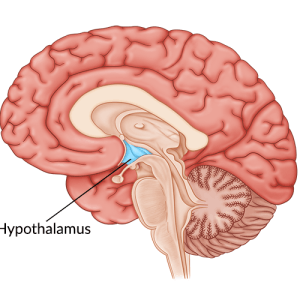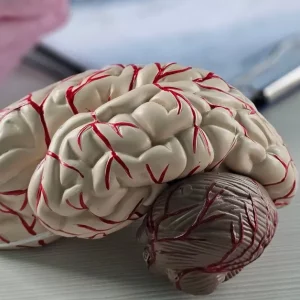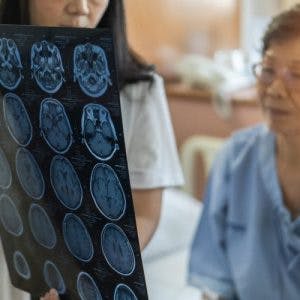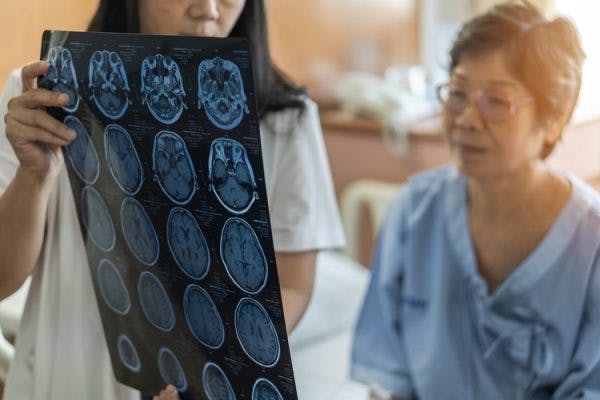The corpus callosum connects the left and right hemispheres of the brain and allows information to pass between sides. While damage to the corpus callosum is rare, it can cause a variety of symptoms that may affect cognitive, emotional, and/or physical abilities. With the help of rehabilitative therapies, individuals may be able to overcome the effects of corpus callosum damage and regain function.
To help you understand what to expect after corpus callosum damage, this article will discuss:
What Is the Corpus Callosum?
The corpus callosum is a hard, C-shaped structure found deep in the middle of the brain. It is made up of a thick bundle of nerve fibers and acts as a connective pathway that links the left hemisphere and the right hemisphere of the cerebral cortex, allowing the two hemispheres to communicate with each other.
Each hemisphere of the brain controls movement and feeling on the opposite side of the body. The corpus callosum acts as a bridge so that input from the left side of the brain can transfer to the right side and vice versa.
In addition to serving as a bridge between the two hemispheres, the corpus callosum also plays a role in higher cognitive function. Research has shown that this structure is involved in complex abilities such as:
- Memory
- Learning
- Executive functions
- Three-dimensional vision
- Visual reaction time
Injury to the corpus callosum can cause problems with these cognitive functions and affect many aspects of daily life. However, not all the effects of corpus callosum damage are cognitive.
What Happens If the Corpus Callosum Is Damaged?
Since the corpus callosum is responsible for relaying information between both hemispheres of the brain, it is crucial for maintaining balance and coordination. Both hemispheres of the brain must work together to coordinate movement, communicating sensory and motor information with each other via this connective pathway. Therefore, damage to the corpus callosum may result in a wide variety of impairments if this communication is disrupted.
Along with providing sensory and motor communication across both hemispheres of the brain, the corpus callosum contributes to cognitive functions such as problem solving, attention, and memory. Therefore, corpus callosum damage can also cause cognitive and emotional changes, which we will discuss in this article.
The wide variety of symptoms or impairments following damage to the corpus callosum are often grouped into a broader diagnosis, called corpus callosum syndrome.
The most common effects related to corpus callosum damage include:
Pseudobulbar Palsy
Pseudobulbar palsy is a condition that affects the ability to control the tongue and facial muscles, making it difficult to chew, swallow, or speak.
Individuals with pseudobulbar palsy often demonstrate:
- Dysarthria, or slurred speech
- Dysphagia, or difficulty swallowing
- Dysphonia, or spasms in the vocal cords that cause poor voice quality
- Emotional lability, or exaggerated mood swings
- Drooling
Although the brainstem controls most facial muscles, these signals must pass through the corpus callosum. Therefore, if it becomes damaged, difficulties with facial movement can occur.
Speech and Movement Ataxia
When corpus callosum damage hinders communication between both hemispheres of the brain, it can lead to speech and movement ataxia. Ataxia refers to a lack of control or coordination of voluntary movements, meaning movements will appear abnormal or clumsy.
Depending on which muscles are affected, this could cause problems with:
- Walking
- Balance
- Speech
- Swallowing or facial expressions
- Eye movements
- ADL’s (activities of daily living)
A speech-language pathologist can diagnose and help rehabilitate any speech-related issues like ataxia of speech or swallowing difficulties after brain injury. A physical or occupational therapist can help diagnose and rehabilitate motor ataxia, which we will discuss later.
Alien Hand Syndrome
Perhaps one of the strangest potential symptoms of corpus callosum damage is a condition known as alien hand syndrome. While it most commonly affects the left hand, it can affect the right in some rare cases. This condition causes the hand to seemingly move and act on its own without any cognitive control or awareness from the person.
These movements are not simply random, involuntary muscle spasms either. Instead, the affected hand performs goal-oriented tasks, as if it is being controlled by someone else.
For example, the person’s hand might pick up an object, touch their face, or button their shirt without any conscious input. Sometimes the hand might engage in counterproductive actions, such as closing a door that the other hand just opened. In some extreme cases, the hand has tried to harm the patient by choking them.
People with alien hand syndrome often feel like their hand is foreign. However, they do not deny ownership of their hand, as occurs in other neurological disorders, such as left neglect.
Rehabilitation for Corpus Callosum Damage
Rehabilitation after neurological injury revolves around the phenomenon of neuroplasticity: the mechanism the brain uses to heal and rewire itself. When the corpus callosum sustains damage, neuroplasticity allows other healthy areas of the brain to take on (or compensate for) lost function.
Many of the effects of corpus callosum damage can be remedied, at least partially, through rehabilitation. Because the effects of this brain injury can include cognitive, motor, and speech impairments, the rehabilitation process may involve working alongside several different therapists.
Speech & Cognitive Therapy
Individuals that experience facial movement problems, pseudobulbar palsy, or speech ataxia can benefit from speech therapy exercises. Every brain injury is different, so a speech-language pathologist can help choose the most appropriate exercises for each individual’s specific needs. For example, individuals with dysphagia may practice swallowing exercises during their speech therapy sessions in order to help make eating safer and more efficient.
For those who develop cognitive impairments such as memory loss or executive dysfunction, cognitive rehab exercises can be helpful. These exercises challenge the person to practice various cognitive skills that may have been affected by corpus callosum damage.
For example, if attention has become impaired, a cognitive exercise like symbol hunting can help retrain attention. When practiced consistently, cognitive exercises help activate neuroplasticity and encourage cognitive function to improve over time.
This symbol hunting exercise is an example from the CT Speech & Cognitive Therapy App. The app contains an expansive library of different speech and cognitive exercises that patients can practice at home to maximize their recovery.
Physical & Occupational Therapy
When corpus callosum damage causes difficulty with movement, physical and occupational therapists can help survivors regain function through therapeutic exercises and activities. Physical therapists can provide specific rehab exercises that target balance, coordination, and mobility to help improve function, even with motor ataxia. Occupational therapists can also help survivors regain independence with activities of daily living such as dressing, preparing meals, and bathing.
Unfortunately, there are very few treatments available for alien hand syndrome and more research is still needed. However, some studies have shown promising results using mirror box therapy.
In the meantime, occupational therapists can help individuals adapt to using only one hand and provide helpful methods to compensate for the uncontrollable hand. In extreme cases, a sling may be necessary to prevent the arm from moving or causing harm.
Understanding Corpus Callosum Damage
The corpus callosum is a crucial brain structure that connects the right and left hemispheres. Damage to this structure can cause cognitive and physical effects and, in rare cases, alien hand syndrome.
Fortunately, there are many therapy techniques available that can help after corpus callosum damage. Individuals with impaired balance and coordination (ataxia) can benefit from physical and occupational therapy. Others with speech difficulties, such as apraxia of speech or swallowing difficulties, can benefit from speech therapy.
The key to recovery is to activate neuroplasticity through therapeutic exercises. With time and diligence, survivors of corpus callosum damage can maximize their chances of recovery and improve function with daily activities.











